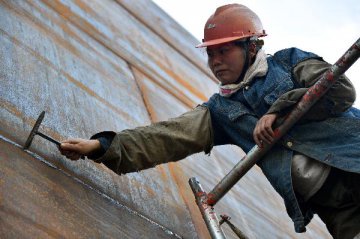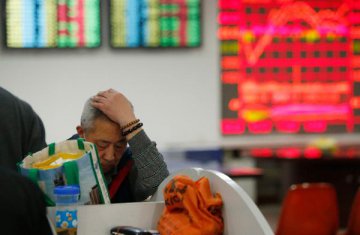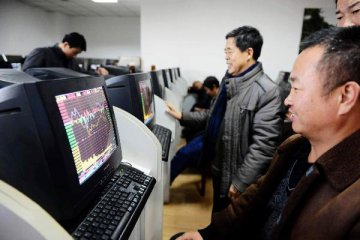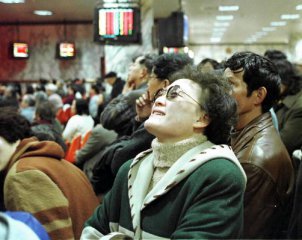
Looking back, A-share market, which have brought mixed feelings of grief and joy to investors in 2015, will open a new chapter soon as the New Year is around the corner. We have summarized words that are closely associate with the trend of A shares in 2015, and concluded “ten hot words dominating stock market in 2015”, hoping readers may gain an insight into the stock market and get the “code” of A shares investment.
No.1 Leverage
The SSE Composite Index closed at 3,234.68 points on the last trading day of 2014. Entering 2015, it has experienced leveraged bull run and hiked for months before reaching the peak of 5,178.19 points on June 12, 2015. But the market reversed as the de-leverage process deepened. Following massive and panic sell-offs seen in frequent “thousands stocks plummeting by the daily limit of 10 percent”, the SSE Composite Index vertically fell back to 2,300 points within less than two months, and again hit another new low of 2,850.71 points on Aug.26, 2015.
As it were, leverage held A-share market up in 2015, and dragged it down. Data shows that during the year, the balance of margin financing and securities lending once peaked to 2.27 trillion yuan, and assets of off-market margin financing aggregated nearly 500 billion yuan. Analysts indicated that leverage is a double edged sword: when the market surges, leverage brings positive feedback to investors; while any pulling back happens, the range of drop may be amplified by leverage, and as a result positive feedbacks turns into negative ones.
No.2 Bailout
No one could have expected that the strongly rising A-share market in the first half year may crash. The SSE Composite Index fell by nearly a half in 52 trading days from the middle of June to the end of Aug. During the trading sessions, massive stocks could be seen to have plummeted by the daily limit of 10 percent. Meanwhile, regulators introduced various stabilizing measures, including postponing IPO issuance, securities companies providing no less than 120 billion yuan for investment in blue-chip ETF, the central bank providing liquidity for China Securities Finance Corporation Limited (CSFC), prohibition of controlling shareholders and shareholders, directors of the board, supervisors and senior management members with more than 5 percent shareholding in a listed company from selling shares of the company through secondary market in certain period of time. Besides, the Ministry of Public Security and China Securities Regulatory Commission (CSRC) jointly investigated “malicious short selling”.
What’s more, six out of the 21 domestic securities companies consisting “national bailing out team”, including the representative Citic Securities, have been investigated so far. The team is organized by CSFC and led by Zhang Yujun, former assistant to the chairman of the CSRC. And Zhang, the “captain of the bailing out team”, was investigated in September due to serious violation of discipline.
No.3 State-owned enterprises (SOEs) reform
On Sept.13, top level design for SOEs reform was launched. A series of recent massages show that SOEs reform is accelerating. Lian Weiliang, Deputy Director of the National Development and Reform Commission (NDRC) indicated at the thirteenth China reform forum that reform of SOEs and major industries will deepen next year, and mixed ownership reform in important sectors like electricity, oil and gas, telecommunication and military industry will be carried out.
It is widely believed that as reorganization and integration of central enterprises accelerate and mixed ownership reform speeds up, vitality of enterprises will be activated and core competitiveness of SOEs will be improved, adding new impetuses to the stock market.
No.4 Internet Plus
On Dec. 14, the Ministry of Industry and Information Technology issued three-year action plan in respect of “Internet Plus”, proposing to further deepen the integration of internet and manufacturing, and improve digital, network and intelligence elements in manufacturing. It also covered seven action plans such as cultivation and promotion of intelligent manufacturing. In this year’s government work report, Premier Li Keqiang put forward for the first time to “formulate ‘Internet Plus’ action plan, promote the integration of mobile internet, cloud computing, big data, internet of things with modern manufacturing industry, facilitate sound development of ecommerce, industrial internet and internet finance, and guide internet companies’ expansion abroad.
Analysts say that China pays high attention to the development of internet industry. With the popularization and development of wide band, industries synergizing with internet have also get on fast track. As the market gradually opens wider, earlier entrants are expected to enjoy excessive earnings from growth.
No.5 Made in China 2025
At the “Two Sessions” at the beginning of the year, “Made in China 2025” appeared in government’s work report for the first time. In the middle of May, the State Council issued Made in China 2025, aiming to comprehensively deploy and implement the strategy of building China into a manufacturing power. The document envisions China to rank as manufacturing power by 2025, and the overall manufacturing industry to stand on the medium range among the world’s manufacturing powers.
Analyses generally concluded that “Made in China 2025” has set a standard for traditional manufacturing enterprises to build intelligent factories. Along with the transformation and upgrading of manufacturing industry and the advancement of Internet Plus, “Made in China 2025” will continue to be a hot spot in the A-share market this year, and even in the next few years.
No.6 Civil-military integration
Along with the opening of military industry, civil-military integration goes deep under the support of national policies, and it has become a trend and a national strategy. Insiders believe that civil-military integration is likely to be accelerated and enhanced during the period of “13th Five-Year Plan”.
According to the statistics, since 2005 when China issued various policies successively to support the private enterprises to step into the field of national defense construction, an increasing number of private enterprises have started to enter into the supply system for national defense and military industry. Based on public data, over 500 private enterprises have been issued licenses to carry out scientific researches and productions for weaponries.
No.7 Healthy China
The Fifth Plenary Session of the 18th Communist Party of China Central Committee meeting proposed to boost the construction of Healthy China. At the beginning of September this year, the National Health and Family Planning Commission fully initiated the formulation of Plan on Constructing the Healthy China (2016-2020). Analyses show that to rise “Healthy China” as a national strategy will comprehensively promote reform on medicine and health care system.
Ping An Securities indicates that during the “13th Five-Year Plan” period, medical treatment and healthcare industry focusing on big health and medicine is likely to reach a market scale of 10 trillion yuan. This industry also will take the lead in a new round of economic development, and sub-fields of medical service, health insurance, innovative drugs, precision medical treatment as well as cloud-networking medical treatment will gain great achievements.
No.8 Universal Two-child Policy
The Fifth Plenary Session of the 18th Communist Party of China Central Committee meeting proposed to carry out the Universal Two-child Policy for each couple, and positively deal with the issues related to aging population, so as to enhance the balanced development of population, insist the basic state policy of family planning, and improve the strategy on population development. According to scholars, implementation of the two-child policy will have relatively-direct impact on infant and toddler products and related industries. Birth and growth of each child involve many industries, such as education, medical treatment and housing. Consumptions on newly-born infants and related multiplier effect will activate the vigor of the market, and promote the development of related industries.
Founder Securities (601901.SH) points out that based on the rough calculation that average parenting cost of 200,000 yuan in urban or rural areas for children before the age of 16, second-child baby boom will bring annual consumption dividends from 120 to 160 billion yuan.
No.9 13th Five-Year Plan
2015 will pass soon, but as one of the ten key words in this year, “13th Five-Year Plan” has just been initiated. Based on analysis, “13th Five-Year Plan” will arouse substantial theme investments, which are likely to become a mainline for the trend at the end of this year or even in the next year. It is worthy to notice that strength is intensified now to formulate the 13th Five-Year Plan for various industries. Most of the policies are expected to be issued successively in 2016. Therefore, conceptual hype on the 13th Five-Year Plan for various industries is possibly to appear next year. However, it may be the best time to make deployment now when the trend is not that high.
Zhu Zhenxin, senior macro economy researcher of Minsheng Securities Research Institute, indicates that the 13th Five-Year Plan covers many investment opportunities that worth the attention of investors, especially in the investment sectors, such as information economy represented by big data strategy, Internet power, information-industry integration, and information security, Beautiful China represented by ecological environment protection and new energy, Healthy China represented by pension, health, medical treatment, opening development represented by domestic and overseas markets, sharing development represented by civil-military integration and SOEs reform, as well as entertainment.
No.10 Registration-based IPO system
China Securities Regulatory Commission on Dec. 9 announced that it will gradually implement the registration-based IPO system within two years, and formulate the regulations for related departments and standards, such as measures on administration of public offering and registration of shares in line with institutional arrangements determined by the State Council. In terms of current situation, it is commonly expected in the industry that registration-based IPO system will be implemented in next year at the soonest, based on preparation work including legal process and timetable on revising regulations.
According to the analysis, registration-based IPO system will benefit the improvement on A-share system, make value investment more standardized, and change the speculative behaviors on A shares. Meanwhile, registration-based IPO system will not create a large-scale of expansion on new shares at once. Therefore, such system will benefit the medium and long-term development of the stock market.
Translated by Jelly Yi and Adam Zhang























Latest comments